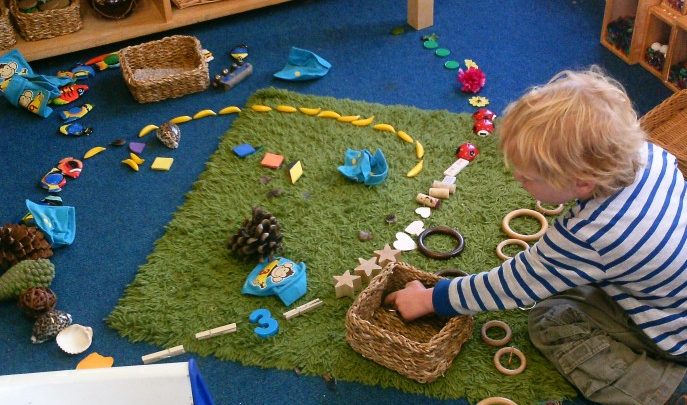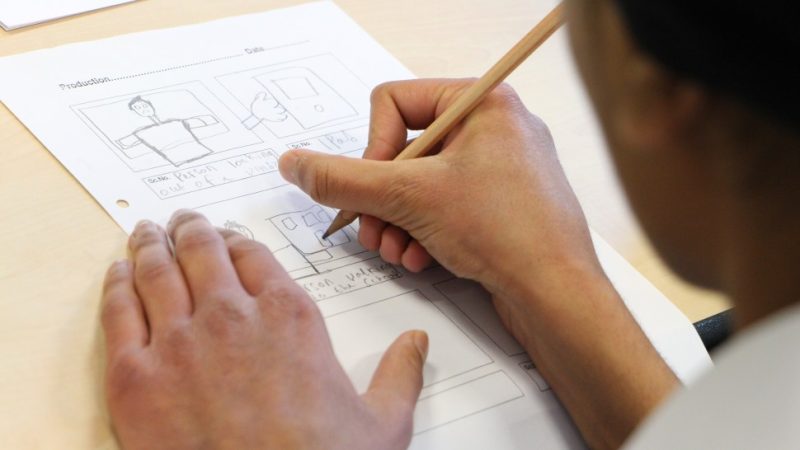Why you should try transient art

Leave the paint and the glue in the cupboard, share out some loose parts and let children be creative on their own terms…

A few years ago I met a little boy who desperately wanted to paint but couldn’t find a piece of paper. I offered him a coloured piece and was told, “That’s for cutting, not for painting.”
He wouldn’t paint until he had the same rectangular piece of white paper he had always been supplied with. He painted the same picture he had been praised for previously. He was terrified of exploring anything beyond what he had already experienced.
At that point my commitment to encouraging children to express themselves and their individual creativity was cemented. My enthusiasm for the use of loose parts grew further still, and my love of ‘transient art’ came into its own.
Transient art, by its name and nature, is ‘art that’s moveable’. Put simply, it’s the use of lots of materials to create a picture, pattern or structure; a process of creating with loose parts with no permanent end product; a way of creating both indoors and out whilst incorporating many other elements of learning.
Using loose parts as an open-ended resource in early years has been advocated since the 1970s when Simon Nicholson coined the phrase and noted that, “creativity and the possibility of discovery are directly proportional to the number and kind of variables”.
In other words, if we give children lots of different materials to work with, the learning opportunities become endless, restricted only by the child’s own imagination. The availability of lots of resources with no right or wrong use is now embedded in best practice and supports learning across the EYFS, not just in creativity.
The term ‘transient art’ encompasses this creative side to using loose parts but, as with other types of child-led learning, goes hand in hand with other areas of development.
Transient or fixed?
Traditional art offerings in early years require children to paint or stick, resulting in a permanent end product. Once the painting, gluing or cutting has been completed, there’s little room for retracing your steps or reworking without completely starting over.
For children still building confidence in both their own skills and style, this approach can be restrictive and demoralising, and may result in avoidance for fear of failure or being unable to achieve their desired effect.
Transient art offers an opportunity for children to create and explore ideas without such pressures. Children quickly realise that the non-permanent nature of their creations allows them to move, to change, to experiment and to explore.
They are able to combine materials, to design and redesign, to take apart and put back together until they’re happy with what they have achieved. They are able to explore colour, texture and shape with freedom and individuality, knowing that there is no right or wrong result. They grow in confidence as they build on their own ideas and explore their own thinking.
Indoors and out
Transient art can, and should, be offered both indoors and outdoors. Outdoors it is commonly referred to as ‘land art’, which has been made popular by artists such as Andy Goldsworthy and Richard Shilling.
Land art, as the name suggests, uses all the resources of the earth and nature as its inspiration. For example, leaves of many colours can be combined with pine cones, sticks, stones, shells and logs to create amazing patterns and pictures.
As with much outdoor learning, it can embrace the space offered and lead to much larger-scale creations that encourage cooperation and communication skills as children work together. Indoor transient art resources tend to be a combination of both natural and man-made materials, including glass beads, bead strings, material scraps, shells and pebbles.
Space to create
Working with loose parts takes some planning from the practitioner. The resources need to look inviting so children will come and explore, and need to be both accessible and mobile. Baskets are an ideal storage solution and allow children to move the resources to where they choose to create.
Offering a selection of mirrors and wooden picture frames gives children a defined space to work with – creating a picture within the frame that can be tweaked and added to until the child is happy with the result. As well as planning for the resources, you also have to plan for the space and time for children to create: children need room to spread out, to develop their ideas and the time to follow these through without interruption.
Displaying CoEL
As with the use of other loose parts such as block play, transient art offers an opportunity for children to access and display many Characteristics of Effective Learning.
If the invitation to play is exciting enough, children will naturally play and explore; will become engrossed in their own thinking and ideas; will change and rearrange their creations, problem-solving as they go; and will delight in achieving what they set out to do – all while being creative and thinking critically.
Recording the process
The moveable nature of this approach means the focus for learning is firmly on the process of thinking and rethinking, rather than on the end product, which cannot be displayed in a gallery alongside paintings and collages.
As such the recording of transient art needs to go hand in hand with recording the learning process. A photograph can record the end product, but multiple photographs will record the process of learning that took place in getting to the end result. Needless to say, the latter is much more useful in assessing learning and as a tool for supporting children’s ongoing development.
Try it yourself
So next time you place a sunflower on a table and expect children to reproduce it for a display, or you place your rectangular piece of paper on your painting easel with the same four colours pots, ask yourself, “Am I really offering something that actively encourages creative thinking and individual expression? Am I creating to display or displaying creativity?” Maybe it’s time to add transient art to your continuous provision, sit back and watch the creativity and confidence unfold in front of you.
It’s easy to get started. Collect as many loose parts as you can, both natural and man-made. You can find cheap old mirrors and picture frames at car boot sales and charity shops, glass beads from home furnishings and pound shops, and material and wood from scrapstores. Visit scrapstoresuk.org for your nearest scrapstore, and see Stimulating Learning with Rachel (stimulatinglearning.co.uk) – a great page with lots of transient art inspiration.
Links with maths
The open-ended, play-based nature of transient art lends itself to learning across the EYFS, but opportunities for maths learning abound, in particular…
- Children can explore and talk about repeating patterns, non-standard shapes such as spirals, and comparisons of size
- Creating artworks on mirrors affords first-hand experience of reflection and symmetry
- The fluid nature of the process enables children to experiment with using space as they build their creations
Transient art helps to make all of these concepts more ‘real’, building on children’s interests and negating the need for formalised, adult-led tasks. It allows practitioners to look for the maths in the play rather than taking the children to the maths.
Kirstine Beeley is an author and educational consultant. Her new book, This is how we do it! Characteristics of Effective Learning in Early Years, is available now from playingtolearnuk.com.











